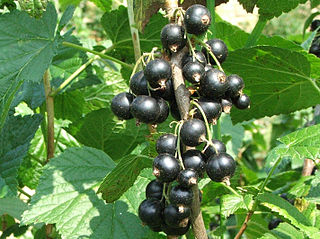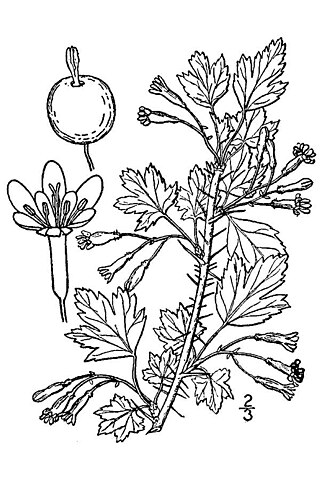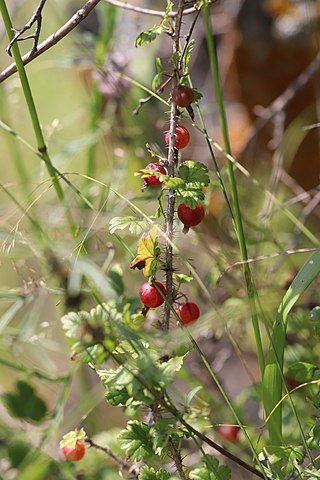
Rusts are plant diseases caused by pathogenic fungi of the order Pucciniales.

Gooseberry is a common name for many species of Ribes, as well as a large number of plants of similar appearance. The berries of those in the genus Ribes are edible and may be green, orange, red, purple, yellow, white, or black.

The blackcurrant, also known as black currant or cassis, is a deciduous shrub in the family Grossulariaceae grown for its edible berries. It is native to temperate parts of central and northern Europe and northern Asia, where it prefers damp fertile soils. It is widely cultivated both commercially and domestically.

Ribes is a genus of about 200 known species of flowering plants, most of them native to the temperate regions of the Northern Hemisphere. The various species are known as currants or gooseberries, and some are cultivated for their edible fruit or as ornamental plants. Ribes is the only genus in the family Grossulariaceae.

Amelanchier alnifolia, the saskatoon berry, Pacific serviceberry, western serviceberry, western shadbush, or western juneberry, is a shrub with an edible berry-like fruit, native to North America.

Camassia quamash, commonly known as camas, small camas, common camas, common camash or quamash, is a perennial herb. It is native to western North America in large areas of southern Canada and the northwestern United States.

Fragaria virginiana, known as Virginia strawberry, wild strawberry, common strawberry, or mountain strawberry, is a North American strawberry that grows across much of the United States and southern Canada. It is one of the two species of wild strawberry that were hybridized to create the modern domesticated garden strawberry.

Maianthemum racemosum, the treacleberry, feathery false lily of the valley, false Solomon's seal, Solomon's plume or false spikenard, is a species of flowering plant native to North America. It is a common, widespread plant with numerous common names and synonyms, known from every US state except Hawaii, and from every Canadian province and territory, as well as from Mexico.

Cronartium ribicola is a species of rust fungus in the family Cronartiaceae that causes the disease white pine blister rust. Other names include: Rouille vésiculeuse du pin blanc pin (French), white pine Blasenrost (German), moho ampolla del pino blanco (Spanish).

Sambucus nigra is a species complex of flowering plants in the family Adoxaceae native to most of Europe. Common names include elder, elderberry, black elder, European elder, European elderberry, and European black elderberry. It grows in a variety of conditions including both wet and dry fertile soils, primarily in sunny locations. The plant is widely grown as an ornamental shrub or small tree. Both the flowers and the berries have a long tradition of culinary use, primarily for cordial and wine.

Phoenicaulis is a monotypic genus of flowering plants in the family Brassicaceae found in western North America. It contains the single species Phoenicaulis cheiranthoides, which is known by the common names daggerpod and wallflower phoenicaulis. The genus name means 'reddish-purple stems', probably in reference to the tendency for the stems to take on such a color, and the species name means 'hand of flowers'.

Castilleja applegatei is a species of Castilleja known by the common names Applegate's Indian paintbrush and wavyleaf Indian paintbrush.

Festuca idahoensis is a species of grass known by the common names Idaho fescue and blue bunchgrass. It is native to western North America, where it is widespread and common. It can be found in many ecosystems, from shady forests to open plains grasslands.

Ribes aureum, known by the common names golden currant, clove currant, pruterberry and buffalo currant, is a species of flowering plant in the genus Ribes native to North America.

Antennaria rosea is a North American species of flowering plant in the family Asteraceae known by the common name rosy pussytoes. Other common names include cat's foot and mountain everlasting. The second part of its scientific name, rosea, is Latin for pink. It is widespread across much of Canada including all three Arctic territories, as well as Greenland, the western and north-central United States, and the Mexican state of Baja California.

Chrysothamnus viscidiflorus is a species of shrub in the family Asteraceae of the Americas known by the common names yellow rabbitbrush and green rabbitbrush.

Crepis modocensis is a species of flowering plant in the family Asteraceae known by the common name Modoc hawksbeard.

Ribes oxyacanthoides is a species of flowering plant in the gooseberry family known by the common name Canadian gooseberry. Its various subspecies have common names of their own. It is native to North America, where it occurs in Alaska through much of Canada and the western and north-central United States.

Ribes aciculare is a species of flowering plant in the currant/gooseberry family Grossulariacea, generally regarded as closely related to Ribes burejense. It is native to central and northern Asia, and has been reported as native to Altay, Kazakhstan, Krasnoyarsk, Mongolia, Tuva, West Siberia, Xinjiang. Its habitats vary from stony hill and mountain slopes to forest margins and thickets. In Northern China it has been found at altitudes of 1,500-2,100 metres. The plant is very cold hardy, and can tolerate temperatures down to -20°C during dormancy.




















